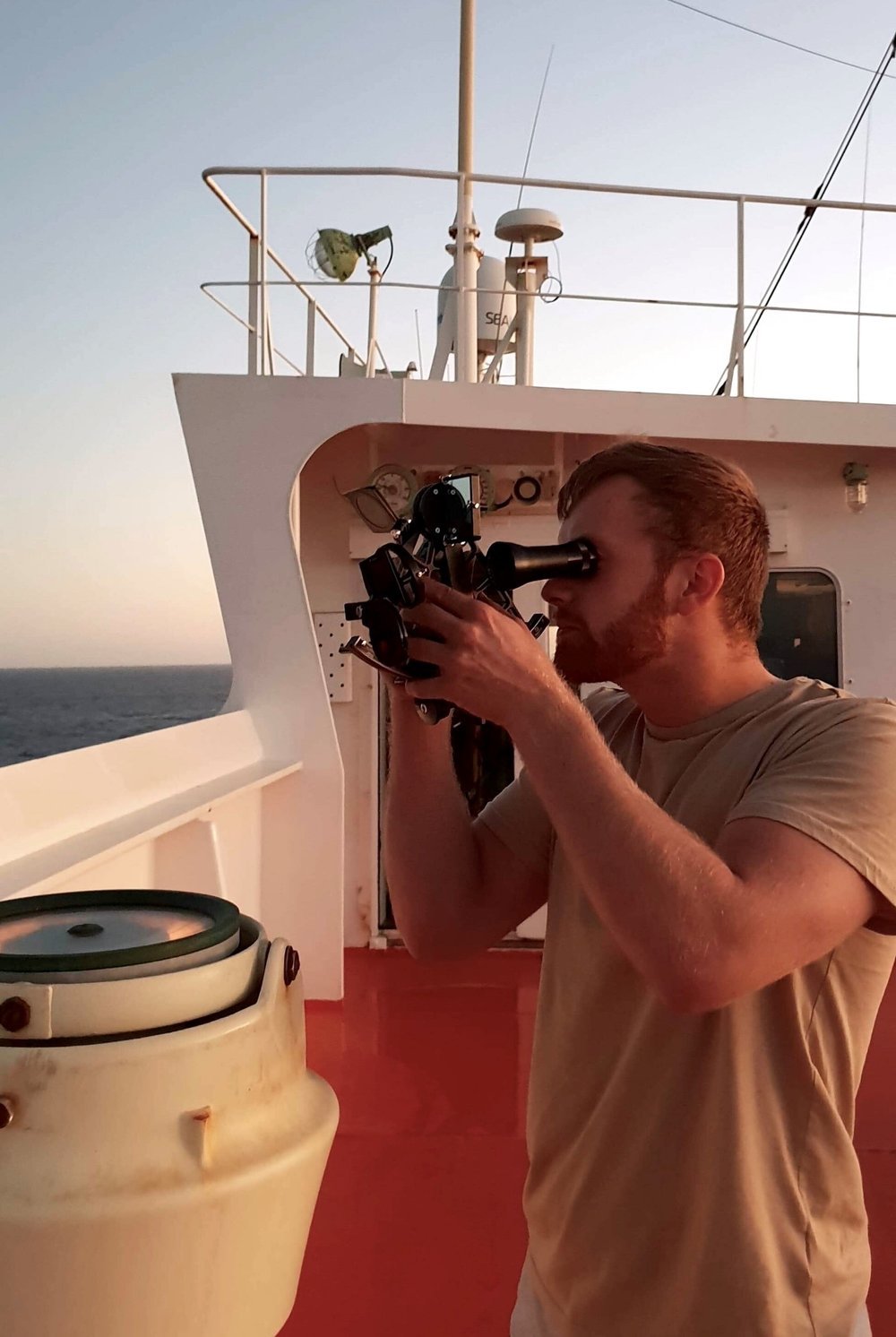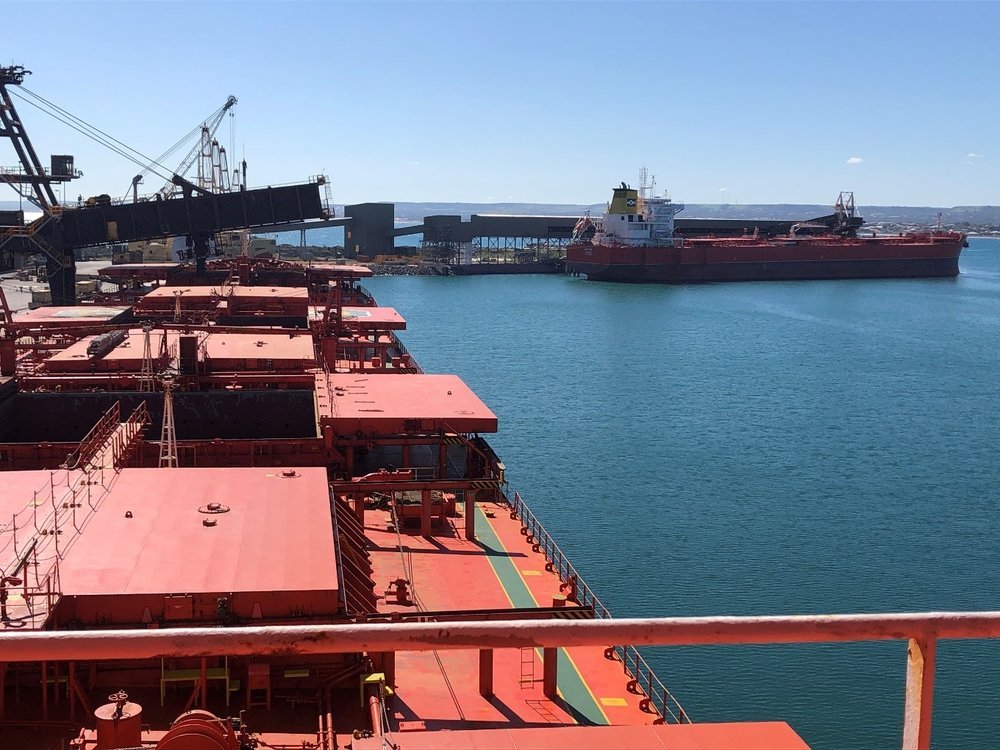Determining the ships position using only the stars, a compass and a sextant
Image: Henrik Reiten on board the MV Banastar, operating a sextant to find the position of the vessel
This year’s travelling intern, Henrik Reiten spent 9 weeks on board the CABU MV Banastar, and learnt a thing or two that he did not anticipate. Reiten is a second-year student in Marine Technology at the Norwegian University of Science and Technology in Trondheim and will be starting his third year now that he has returned from his time on board the MV Banastar.
This year’s Sea Going Experience candidate shares:
It all started with a trip to the head office in Oslo, where I had my medicals done, applied for my visa to Chinese, and had lunch with some of the Klaveness staff. I was given a quick presentation about the company and what to expect during my time on board the vessel M/V Banastar. Before I knew it, I was on a plane heading for Bahrain.
The company had planned an internal audit, so I was lucky to travel alongside one of the Klaveness staff from the office in Oslo. Due to some delay, a couple of extra nights were spent in the hotel in Bahrain before signing on. Arriving the docks of Manama, the big orange vessel showed herself. It was finally time to walk up the gangway for the first time. I was introduced to the crew and staff, and quickly found my place amongst the engine crew. The first days were spent familiarizing with the safety routines, different areas of the ship and getting to know my colleagues. I was also able to join some of the crew for a trip on shore to visit the city of Manama.
After 5 days of discharging alumina we sailed north, towards the port of Al Jubail, Saudi Arabia. Two days later and 54 000 tons of caustic soda heavier we were on the way down the Persian Gulf and south east towards the land down under, Australia. The voyage took 20 days and was followed up with some days at anchorage before we finally could berth. During the voyage I got to spend some time with both the deck department and on the bridge. Daily maintenance on deck such as painting, removing rust and cleaning the cargo holds occupied my days, but I was also familiarized with the cargo handling equipment, general routines and the ballast system. The officers on the bridge introduced me to the navigational equipment as well as challenging me to manoeuvre the vessel manually, which showed itself to be more difficult than expected. I even got to learn how to determine the ships position using only the stars, a compass and a sextant.
When arriving Kwinana I was put in charge of the discharging operation, of course under surveillance of the chief officer. A discharge plan was made pre-arrival to ensure sufficient strength and stability during the operation. All went well, and after a week on the west coast of Australia we had managed to discharge all the caustic soda and load the ship with iron ore. During our stay I was able to go ashore both in Kwinana and our loading port, Geraldton. The next destination was China. The voyage took about two weeks, which I got to spend together with the engine crew. Accompanying the engineers during maintenance of the different machinery was a great way to learn how everything collaborates. They also gave me the opportunity to visit the different enclosed space areas. This would be areas such as the ballast tanks, double bottom and even inside the main engine. Of course, extra safety precautions are taken while visiting these areas.
Image: First generation CABU along second generation CABU, both with inbound wet cargo and outbound iron ore cargoes from Australia.
During the last voyage we encountered some bad weather. Several typhoons were spotted ahead of us. It was interesting to cooperate with the captain during his evaluation of the weather forecast and deciding which adjustments to do to avoid the worst of it. With a variety of weather and great views while sailing past the islands of Indonesia and Philippines, it was a great way to finish off my sea going experience.
Life on board the MV Banastar
The hospitality of the crew made it easy to quickly feel a part of the group. With the total of five different nationalities living together under the same roof, a lot of cultural differences will show. The respect they show each other is inspiring, and it has been interesting to learn about the different cultures.
Image: From our drill on being rescued from a ballast tank
The safety on board is a number one priority. To maintain knowledge about this, weekly drills, familiarizations and routines are completed. Every Saturday we had a fire and lifeboat drill. Additional drills where also completed during my stay, such as emergency steering gear and rescue from enclosed space. The life of a seafarer includes many risks, so a good safety management system as well as focus on the topic is important. Pollution and disposal of garbage and sewage is also an important topic at sea. To see the plastic floating around in the ocean was an eye opener. During my stay I learned about the different routines to avoid environmental damage and to satisfy the requirements from MARPOL.
I would like to thank the staff in the office for giving me this opportunity. The experience is of great value, and I will for sure bring the knowledge that I have obtained during my stay back to the school bench. Finally, I would like to thank the crew of MV Banastar for this adventure. Not only for the knowledge you have shared with me, but also for the stories, ping pong matches and band nights. Thank you!



